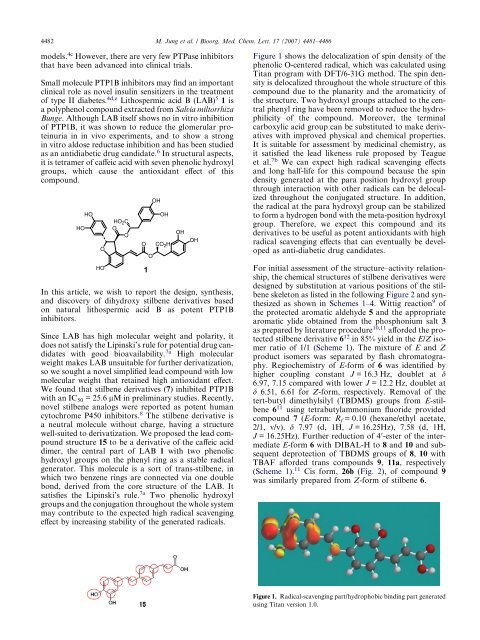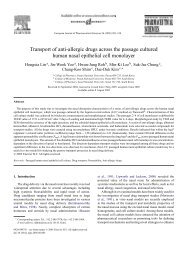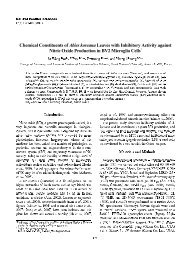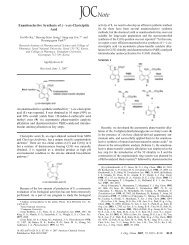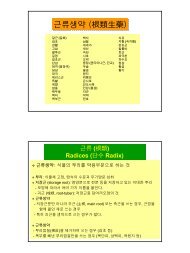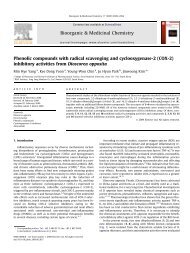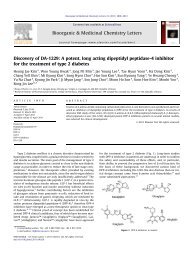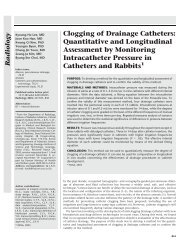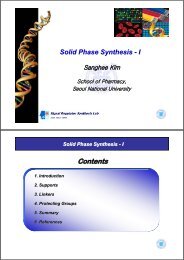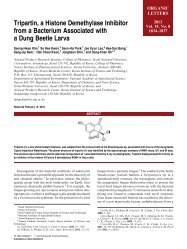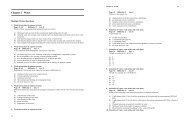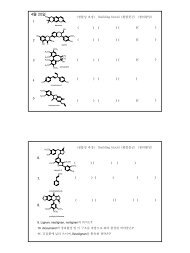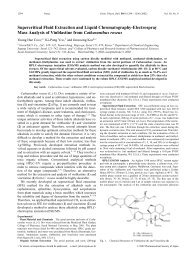Design, synthesis, and discovery of stilbene derivatives based on ...
Design, synthesis, and discovery of stilbene derivatives based on ...
Design, synthesis, and discovery of stilbene derivatives based on ...
Create successful ePaper yourself
Turn your PDF publications into a flip-book with our unique Google optimized e-Paper software.
4482 M. Jung et al. / Bioorg. Med. Chem. Lett. 17 (2007) 4481–4486models. 4c However, there are very few PTPase inhibitorsthat have been advanced into clinical trials.Small molecule PTP1B inhibitors may find an importantclinical role as novel insulin sensitizers in the treatment<str<strong>on</strong>g>of</str<strong>on</strong>g> type II diabetes. 4d,e Lithospermic acid B (LAB) 5 1 isa polyphenol compound extracted from Salvia miltorrhizaBunge. Although LAB itself shows no in vitro inhibiti<strong>on</strong><str<strong>on</strong>g>of</str<strong>on</strong>g> PTP1B, it was shown to reduce the glomerular proteinuriain in vivo experiments, <str<strong>on</strong>g>and</str<strong>on</strong>g> to show a str<strong>on</strong>gin vitro aldose reductase inhibiti<strong>on</strong> <str<strong>on</strong>g>and</str<strong>on</strong>g> has been studiedas an antidiabetic drug c<str<strong>on</strong>g>and</str<strong>on</strong>g>idate. 6 In structural aspects,it is tetramer <str<strong>on</strong>g>of</str<strong>on</strong>g> caffeic acid with seven phenolic hydroxylgroups, which cause the antioxidant effect <str<strong>on</strong>g>of</str<strong>on</strong>g> thiscompound.HOHOOHOHO 2 COOO1OOHOHCO 2 HIn this article, we wish to report the design, <str<strong>on</strong>g>synthesis</str<strong>on</strong>g>,<str<strong>on</strong>g>and</str<strong>on</strong>g> <str<strong>on</strong>g>discovery</str<strong>on</strong>g> <str<strong>on</strong>g>of</str<strong>on</strong>g> dihydroxy <str<strong>on</strong>g>stilbene</str<strong>on</strong>g> <str<strong>on</strong>g>derivatives</str<strong>on</strong>g> <str<strong>on</strong>g>based</str<strong>on</strong>g><strong>on</strong> natural lithospermic acid B as potent PTP1Binhibitors.Since LAB has high molecular weight <str<strong>on</strong>g>and</str<strong>on</strong>g> polarity, itdoes not satisfy the Lipinski’s rule for potential drug c<str<strong>on</strong>g>and</str<strong>on</strong>g>idateswith good bioavailability. 7a High molecularweight makes LAB unsuitable for further derivatizati<strong>on</strong>,so we sought a novel simplified lead compound with lowmolecular weight that retained high antioxidant effect.We found that <str<strong>on</strong>g>stilbene</str<strong>on</strong>g> <str<strong>on</strong>g>derivatives</str<strong>on</strong>g> (7) inhibited PTP1Bwith an IC 50 = 25.6 lM in preliminary studies. Recently,novel <str<strong>on</strong>g>stilbene</str<strong>on</strong>g> analogs were reported as potent humancytochrome P450 inhibitors. 8 The <str<strong>on</strong>g>stilbene</str<strong>on</strong>g> derivative isa neutral molecule without charge, having a structurewell-suited to derivatizati<strong>on</strong>. We proposed the lead compoundstructure 15 to be a derivative <str<strong>on</strong>g>of</str<strong>on</strong>g> the caffeic aciddimer, the central part <str<strong>on</strong>g>of</str<strong>on</strong>g> LAB 1 with two phenolichydroxyl groups <strong>on</strong> the phenyl ring as a stable radicalgenerator. This molecule is a sort <str<strong>on</strong>g>of</str<strong>on</strong>g> trans-<str<strong>on</strong>g>stilbene</str<strong>on</strong>g>, inwhich two benzene rings are c<strong>on</strong>nected via <strong>on</strong>e doubleb<strong>on</strong>d, derived from the core structure <str<strong>on</strong>g>of</str<strong>on</strong>g> the LAB. Itsatisfies the Lipinski’s rule. 7a Two phenolic hydroxylgroups <str<strong>on</strong>g>and</str<strong>on</strong>g> the c<strong>on</strong>jugati<strong>on</strong> throughout the whole systemmay c<strong>on</strong>tribute to the expected high radical scavengingeffect by increasing stability <str<strong>on</strong>g>of</str<strong>on</strong>g> the generated radicals.OHOHFigure 1 shows the delocalizati<strong>on</strong> <str<strong>on</strong>g>of</str<strong>on</strong>g> spin density <str<strong>on</strong>g>of</str<strong>on</strong>g> thephenolic O-centered radical, which was calculated usingTitan program with DFT/6-31G method. The spin densityis delocalized throughout the whole structure <str<strong>on</strong>g>of</str<strong>on</strong>g> thiscompound due to the planarity <str<strong>on</strong>g>and</str<strong>on</strong>g> the aromaticity <str<strong>on</strong>g>of</str<strong>on</strong>g>the structure. Two hydroxyl groups attached to the centralphenyl ring have been removed to reduce the hydrophilicity<str<strong>on</strong>g>of</str<strong>on</strong>g> the compound. Moreover, the terminalcarboxylic acid group can be substituted to make <str<strong>on</strong>g>derivatives</str<strong>on</strong>g>with improved physical <str<strong>on</strong>g>and</str<strong>on</strong>g> chemical properties.It is suitable for assessment by medicinal chemistry, asit satisfied the lead likeness rule proposed by Teagueet al. 7b We can expect high radical scavenging effects<str<strong>on</strong>g>and</str<strong>on</strong>g> l<strong>on</strong>g half-life for this compound because the spindensity generated at the para positi<strong>on</strong> hydroxyl groupthrough interacti<strong>on</strong> with other radicals can be delocalizedthroughout the c<strong>on</strong>jugated structure. In additi<strong>on</strong>,the radical at the para hydroxyl group can be stabilizedto form a hydrogen b<strong>on</strong>d with the meta-positi<strong>on</strong> hydroxylgroup. Therefore, we expect this compound <str<strong>on</strong>g>and</str<strong>on</strong>g> its<str<strong>on</strong>g>derivatives</str<strong>on</strong>g> to be useful as potent antioxidants with highradical scavenging effects that can eventually be developedas anti-diabetic drug c<str<strong>on</strong>g>and</str<strong>on</strong>g>idates.For initial assessment <str<strong>on</strong>g>of</str<strong>on</strong>g> the structure–activity relati<strong>on</strong>ship,the chemical structures <str<strong>on</strong>g>of</str<strong>on</strong>g> <str<strong>on</strong>g>stilbene</str<strong>on</strong>g> <str<strong>on</strong>g>derivatives</str<strong>on</strong>g> weredesigned by substituti<strong>on</strong> at various positi<strong>on</strong>s <str<strong>on</strong>g>of</str<strong>on</strong>g> the <str<strong>on</strong>g>stilbene</str<strong>on</strong>g>skelet<strong>on</strong> as listed in the following Figure 2 <str<strong>on</strong>g>and</str<strong>on</strong>g> synthesizedas shown in Schemes 1–4. Wittig reacti<strong>on</strong> 9 <str<strong>on</strong>g>of</str<strong>on</strong>g>the protected aromatic aldehyde 5 <str<strong>on</strong>g>and</str<strong>on</strong>g> the appropriatearomatic ylide obtained from the phosph<strong>on</strong>ium salt 3as prepared by literature procedure 10,11 afforded the protected<str<strong>on</strong>g>stilbene</str<strong>on</strong>g> derivative 6 12 in 85% yield in the E/Z isomerratio <str<strong>on</strong>g>of</str<strong>on</strong>g> 1/1 (Scheme 1). The mixture <str<strong>on</strong>g>of</str<strong>on</strong>g> E <str<strong>on</strong>g>and</str<strong>on</strong>g> Zproduct isomers was separated by flash chromatography.Regiochemistry <str<strong>on</strong>g>of</str<strong>on</strong>g> E-form <str<strong>on</strong>g>of</str<strong>on</strong>g> 6 was identified byhigher coupling c<strong>on</strong>stant J = 16.3 Hz, doublet at d6.97, 7.15 compared with lower J = 12.2 Hz, doublet atd 6.51, 6.61 for Z-form, respectively. Removal <str<strong>on</strong>g>of</str<strong>on</strong>g> thetert-butyl dimethylsilyl (TBDMS) groups from E-<str<strong>on</strong>g>stilbene</str<strong>on</strong>g>6 11 using tetrabutylamm<strong>on</strong>ium fluoride providedcompound 7 (E-form: R f = 0.10 (hexane/ethyl acetate,2/1, v/v). d 7.97 (d, 1H, J = 16.25Hz), 7.58 (d, 1H,J = 16.25Hz). Further reducti<strong>on</strong> <str<strong>on</strong>g>of</str<strong>on</strong>g> 4 0 -ester <str<strong>on</strong>g>of</str<strong>on</strong>g> the intermediateE-form 6 with DIBAL-H to 8 <str<strong>on</strong>g>and</str<strong>on</strong>g> 10 <str<strong>on</strong>g>and</str<strong>on</strong>g> subsequentdeprotecti<strong>on</strong> <str<strong>on</strong>g>of</str<strong>on</strong>g> TBDMS groups <str<strong>on</strong>g>of</str<strong>on</strong>g> 8, 10 withTBAF afforded trans compounds 9, 11a, respectively(Scheme 1). 11 Cis form, 26b (Fig. 2), <str<strong>on</strong>g>of</str<strong>on</strong>g> compound 9was similarly prepared from Z-form <str<strong>on</strong>g>of</str<strong>on</strong>g> <str<strong>on</strong>g>stilbene</str<strong>on</strong>g> 6.Figure 1. Radical-scavenging part/hydrophobic binding part generatedusing Titan versi<strong>on</strong> 1.0.


